
The main difference between a client-based UI designer and a product-based UI designer boils down to the work environment and the overall product lifecycle they focus on.
Client-based UI designer:
- Works for agencies or freelance gigs
- Designs interfaces for various clients across different industries
- Focuses on translating client needs and brand guidelines into user interfaces
- May have limited involvement in the user experience (UX) research and testing phases
- Projects are typically shorter-term
Product-based UI designer:
- Works for companies that build and sell their own software products
- Designs interfaces for a specific product or product line
- Has a bigger role in the entire design process, including UX research, prototyping, and user testing
- Works closely with product managers, UX designers, and engineers to create a holistic user experience
- Projects are typically longer-term with a focus on continuous improvement
Here’s a table summarizing the key differences:
| Feature | Client-based UI Designer | Product-based UI Designer |
|---|---|---|
| Work environment | Agency or freelance | Software product company |
| Clients | Multiple, across industries | Single product or product line |
| Focus | Client needs and branding | User experience (UX) |
| Involvement in UX | Limited | Extensive |
| Project duration | Shorter-term | Longer-term |
So, if you enjoy variety and working on different projects with distinct branding needs, then the client-based route might be a good fit. But if you prefer to delve deeper into a single product, focusing on user research and crafting a seamless user experience, then the product-based path might be more appealing.